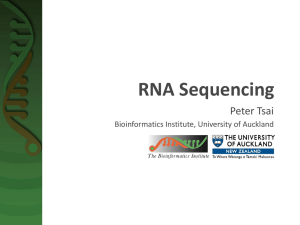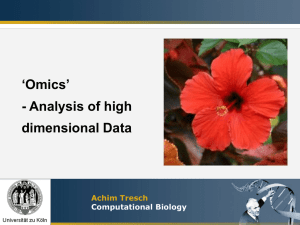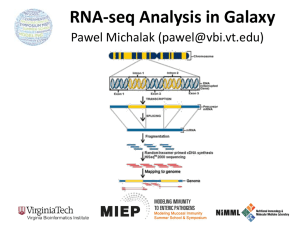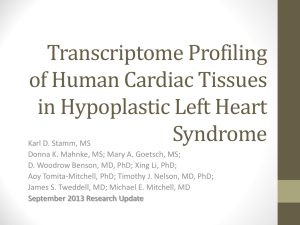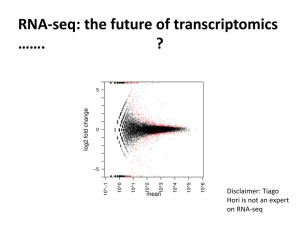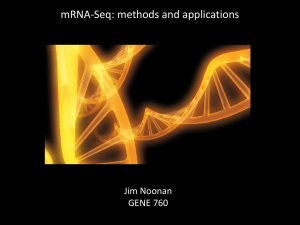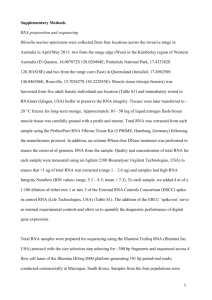Lecture 6 - Tresch Group
advertisement
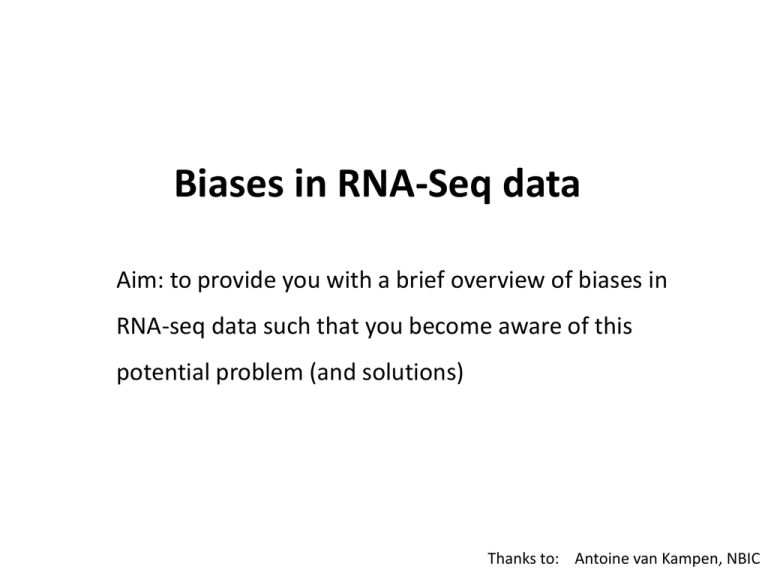
Biases in RNA-Seq data Aim: to provide you with a brief overview of biases in RNA-seq data such that you become aware of this potential problem (and solutions) Thanks to: Antoine van Kampen, NBIC What is the problem? Experimental (and computational) biases affect expression estimates and, therefore, subsequent data analysis: Differential expression analysis Study of alternative splicing Transcript assembly Gene set enrichment analysis Other downstream analyses We must attempt to avoid, detect and correct these biases Types of bias Gene length Mappability of reads e.g., due to sequence complexity Position Fragments are preferentially located towards either the beginning or end of transcripts Sequence-specific biased likelihood for fragments being selected %GC Normalization for gene length and library size: RPKM / FPKM One sample, two transcripts transcript 1 (size = L) Count =6 transcript 2 (size=2L) Count = 12 You can’t conclude that gene 2 has a higher expression than gene 1! Two samples, one transcript transcript 1 (sample 1) Count =6, library size = 600 transcript 1 (sample 2) Count =12, library size = 1200 You can’t conclude that gene 1 has a higher expression in sample 2 compared to sample 1! RPKM: Reads Per Kilobase and Million mapped reads Mortazavi et al (2008) Nature Methods, 5(7), 621 Rewriting the formula Examples Examples Examples Examples FPKM: Fragments per K per M What's the difference between FPKM and RPKM? Paired-end RNA-Seq experiments produce two reads per fragment, but that doesn't necessarily mean that both reads will be mappable. For example, the second read is of poor quality. If we were to count reads rather than fragments, we might double-count some fragments but not others, leading to a skewed expression value. Thus, FPKM is calculated by counting fragments, not reads. Trapnell et al (2010) Nature Biotechnology, 28(5), 511 Other normalization methods Housekeeping genes (Bullard et al, 2010) Upper-quartile (Bullard et al, 2010). Counts are divided by (75th) upperquartile of counts for transcripts with at least one read Quantile normalization (Irizarry et al, 2003; developed for microarrays) Irizarry, et al (2003). Biostatistics (Oxford, England), 4(2), 249–64. Bullard et al (2010) BMC bioinformatics, 11, 94. Robinson & Oshlack (2010). Genome biology, 11(3), R25. Quantile Normalization http://www.people.vcu.edu/~mreimers/OGMDA/normalize.expression.html Schematic representation of quantile normalization: the value x, which is the α-th quantile of all probes on chip 1, is mapped to the value y, which is the α quantile of the reference distribution F2. Gene length bias Gene length bias This bias (a) affects comparison between genes or isoforms within one sample and (b) results in more power to detect longer transcripts 33% of highest expressed genes 33% of lowest expressed genes Oshlack and Wakefield (2009) Biology Direct, 16, 4 Mean-variance relationship . Sample variance across lanes in the liver sample from the Marioni et al (2008) Genome research, 18(9), 1509–17. Red line: for the one third of shortest genes Blue line: for the longest genes. Black line: line of equality Plot A: blue/red lines close to line of equality between mean and variance which is what would be expected from a Poisson process. Mean-variance relationship variance (log 2) mean mean / length Plot B: Counts divided by gene length (which you do when using RPKM). The short genes have higher variance for a given expression level than long genes. Because of the change in variance we are still left with a gene length dependency. Thus, RPKM does not fully correct Mappability bias Uniquely mapping reads are typically summarized over genomic regions Regions with lower sequence complexity will tend to end up with lower sequence coverage Test: generate all 32nt fragments from hg18 and align them back to hg18 Each fragment that cannot be uniquely aligned is unmappable and its first position is considered an unmappable position Expect: uniform distribution Schwartz et al (2011) PLoS One, 6(1), e16685 Mappability bias Unexpected because introns are assumed to have lower sequence complexity in general Exon Since in RNA-seq we align reads prior to further analysis, this step may already introduce a bias. Mappability: dependency on transcript length Reads corresponding to longer transcripts have a higher mappability Sequence-specific bias RNA-Seq protocol Current sequencers require that cDNA molecules represent partial fragments of the RNA cDNA fragments are obtained by a series of steps (e.g., priming, fragmentation, size selection) Some of these steps are inherently random Therefore: we expect fragments with starting points approximately uniformly distributed over transcript. Biases in Illumina RNA-seq data caused by hexamer priming Generation of double-stranded complementary DNA (dscDNA) involves priming by random hexamers To generate reads across entire transcript length Turns out to give a bias in the nucleotide composition at the start (5’-end) of sequencing reads This bias influences the uniformity of coverage along transcript Hansen et al (2010) NAR, 38(12), e131 but also see: Li et al (2010) Genome Biology, 11(5), R50 Schwartz et al (2011) PLoS One, 6(1), e16685 Roberts et al(2011) Genome Biology, 12: R22 Biases in Illumina RNA-seq data caused by hexamer priming position 1 in read A read (35nt) A transcript position x in transcript Determine the nucleotide frequencies considering all reads: What do we expect?? Nucl A C G T Position in read 1 2 3 4 5 ......... 35 We would expect that the frequencies for these nucleotides at the different positions are about equal first hexamer = shaded Bias Frequencies slightly deviate between experiments but show identical relative behavior Distribution after position 13 reflects nt composition of transcriptome is ~constant Effect is independent of study, laboratory, and organisms Apparently, hexamer priming is not completely random These patterns do not reflect sequencing error and cannot be removed by 5’ trimming! nt Example: gene YOL086C in yeast for WT experiment Extreme expression values are removed but coverage is still far from uniform Base level counts at each position unmapple bases Use of spike-in standards Synthetic spike-in standards External RNA Control Consortium (ERCC) ERCC RNA standards range of GC content and length minimal sequence homology with endogenous transcripts from sequenced eukaryotes Jiang (2011) Synthetic spike-in standards for RNA-seq experiments. Genome Research Results suggest systematic bias: better agreement between the observed read counts from replicates than between the observed read counts and expected concentration of ERCC’s within a given library. Count versus concentration*length (mass) per ERCC. Pool of 44 2% ERCC spike-in H. Sapiens libraries Read counts for each ERCC transcript in two different libraries of human RNA-seq with 2% ERCC spike-ins Transcript-specific sources of error Fold deviation between observed and expected read count for each ERCC in the 100% ERCC library • Fold deviation between observed and expected depends on • Read count • GC content • Transcript length Transcript specific biases affect comparisons of read counts between different RNAs in one library Read coverage biases: single ERCC RNA Position effect The ERCC RNAs are single isoform with well-defined ends Ideal for measuring transcript coverage Read coverage biases: 96 ERCC RNAs Position effect Suggested: drop in coverage at 3’-end due to the inherently reduced number of priming positions at the end of the transcript Average relative coverage along all control RNAs for ERCC spiked in 44 H. sapiens libraries. Dashed lines represent 1 SD around the average across different libraries. GC-bias in DNA-seq Correlation of the Illumina read coverage and GC content. 27mer reads generated from Beta vulgaris BAC ZR-47B15.Each data point corresponds to the number of reads recorded for a 1-kbp window This genome is GC poor ~linear relationship reads per kbp GC content (%) Dohm et al (2008) NAR, 36, e105 Some other stuff... Technical bias: cDNA library preparation Bohnert et al, Nucleic Acids Res (2010) Fragmentation effect Sequence specific bias (as also observed in RNAseq experiments) Technical bias: Fragmentation DNA library preparation: Fragmentation of oligo-dT primed cDNA (blue line) is more biased towards the 3′ end of the transcript. RNA fragmentation (red line) provides more even coverage along the gene body, but is relatively depleted for both the 5′ and 3′ ends. Wang et al (2009) Nature reviews. Genetics, 10(1), 57–63. RNAseq may detect other RNA species Tarazona et al (2011) Genome research, 21(12), 2213–23 And more.... • Jones, D. C., Ruzzo, W. L., Peng, X., & Katze, M. G. (2012). A new approach to bias correction in RNA-Seq. Bioinformatics (Oxford, England), 28(7), 921–8. • Risso, D., Schwartz, K., Sherlock, G., & Dudoit, S. (2011). GC-content normalization for RNA-Seq data. BMC bioinformatics, 12(1), 480. • Sendler, E., Johnson, G. D., & Krawetz, S. a. (2011). Local and global factors affecting RNA sequencing analysis. Analytical biochemistry, 419(2), 317–22. • Vijaya Satya, R., Zavaljevski, N., & Reifman, J. (2012). A new strategy to reduce allelic bias in RNA-Seq readmapping. Nucleic acids research, 40(16), e127. • Zheng, W., Chung, L. M., & Zhao, H. (2011). Bias detection and correction in RNASequencing data. BMC bioinformatics, 12, 290. Tools • Wang, L., Wang, S., & Li, W. (2012). RSeQC: quality control of RNA-seq experiments. Bioinformatics (Oxford, England), 28(16), 2184–5. • DeLuca, D. S., Levin, J. Z., Sivachenko, A., Fennell, T., Nazaire, M.-D., Williams, C., Reich, M., et al. (2012). RNA-SeQC: RNA-seq metrics for quality control and process optimization. Bioinformatics (Oxford, England), 28(11), 1530–2. • Picard tools Conclusion Be aware of different types of bias Try to avoid Try to detect Try to correct
